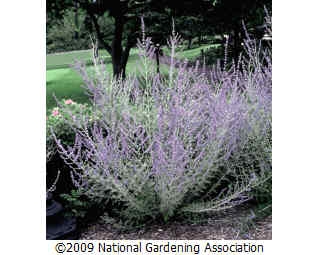Russian Sage

With it airy spires of small, purple-blue flowers and finely-cut, gray-green foliage on upright, grayish-white stems,
Russian sage (Perovskia atriplicifolia) adds a haze of color to the garden from midsummer into fall, blending well with just about any other flower color. With semi-woody stems, this member of the mint family is drought tolerant and trouble-free.
About This Plant
The leaves of this Central Asian native are aromatic when crushed. Most plants reach between 3 and 5 feet tall. While considered hardy in zones 5-9, it struggles where the summers are hot and humid. While most plants sold are listed as
P. atriplicifolia, many are hybrids that are more properly named
P. x hybrida. Regardless of their botanical name, they are a great choice for a water-wise garden.
Special Features
Several cultivars are available.
' Blue Mist ' has paler blue flowers than the species.
'Longin' has a more upright, narrow growth habit.
'Little Spire' gets only about 2 feet tall, with an upright habit. The leaves of
'Filigran' are more finely dissected than the species, giving it an airier appearance.
Site Selection
Full sun and well-drained, even dry soil of average fertility are required for Russian sage to thrive.
Planting Instructions
Container grown plants can be set out throughout the growing season. Space plants 2-3 feet apart. Prepare the garden bed by using a garden fork or tiller to loosen the soil to a depth of 12 to 15 inches, then mix in a 2- to 4-inch layer of compost. Dig a hole twice the diameter of the pot the plant is in. Carefully remove the plant from its container and place it in the hole so the top of the root ball is level with the soil surface. Carefully fill in around the root ball and firm the soil gently. Water thoroughly.
Care
If plants are too floppy, try pinching them back by half in early summer when they are about a foot tall. Cut back plants to about a foot in the fall or leave standing for winter interest. Then cut back to about 6 inches in the spring. Plants at the northern end of their range may be killed back to the ground; in milder areas more of the top growth will survive. Wait to see how much wood had made it through the winter before cutting them back hard in the spring. In long-season areas, if flowering stops after the first flush of blooms, cut back plants by half to encourage a second flush of flowers. Water newly set-out plants if the weather is dry; established plants are quite drought tolerant.






 With it airy spires of small, purple-blue flowers and finely-cut, gray-green foliage on upright, grayish-white stems, Russian sage (Perovskia atriplicifolia) adds a haze of color to the garden from midsummer into fall, blending well with just about any other flower color. With semi-woody stems, this member of the mint family is drought tolerant and trouble-free.
With it airy spires of small, purple-blue flowers and finely-cut, gray-green foliage on upright, grayish-white stems, Russian sage (Perovskia atriplicifolia) adds a haze of color to the garden from midsummer into fall, blending well with just about any other flower color. With semi-woody stems, this member of the mint family is drought tolerant and trouble-free.